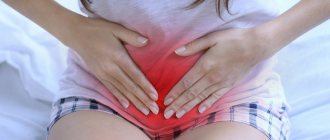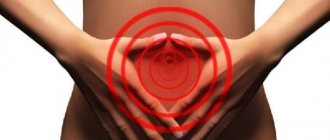As the baby grows and develops, parents gradually learn about possible health problems. A child has a fever and a stomach ache - this is a serious situation that requires qualified help. How to alleviate the baby’s condition, why does the malaise continue, how to prevent the development of diseases of the internal organs?
The child has a stomach ache
If the baby is restless, has poor sleep, whims and frequent crying, this indicates possible pain in the abdominal area. The child is too young to explain to his parents the reason for his anxiety. Adults need to pay close attention to changes in the baby’s behavior in order to correctly determine the source of pain.
Causes and possible diseases
To quickly understand that the pain is caused by the tummy, you can put your hand on it and carefully observe your child for a while. If a child’s temperature rises and the lower abdomen hurts, the cry increases significantly. Now parents need to find out what happened, what is the source of the baby’s pain. There are four options:
- Intestinal colic. The problem occurs in more than 70% of children. Experts have not yet come to a consensus. There are a number of general recommendations that reduce the formation of gases when feeding with breast milk or special formulas.
The baby has severe colic
- Disruption of the digestive process. If the milk has insufficient or excess fat content, the baby develops diarrhea or constipation. During feeding, food is not completely absorbed. If the milk is too fatty, additional water is required. If the percentage of fat is insufficient, it is recommended to increase nutrition with milk formulas.
- Stress. If the psychological climate in the family is bad, the child feels discomfort. When there are changes in the mother’s mood, the baby reacts very sensitively, even to the point of painful symptoms.
- Presence of infection. When viruses and bacteria penetrate a small body, gastroenteritis can develop - “stomach” flu, and a cough can appear. If the disease is of viral etiology, it goes away quite quickly. For bacterial infections, drug therapy is required as prescribed by a pediatrician.
Attention! In rare cases, severe pain and fever in a child may be due to appendicitis or intestinal obstruction. Only a specialist can diagnose the cause.
Rotavirus or stomach flu
The most common disease accompanied by similar symptoms. The age category is not limited; both adults and children fall under it. At the same time, children are more often exposed to rotavirus disease.
At a young age, especially under one year, children are very inquisitive and study all objects by taste. Many things are simply teeming with germs and viruses.
The child's body does not provide any special obstacles to the reproduction and exposure of viruses.
The immune system and digestive system of a small organism are still being formed and strengthened, so any disease easily clings to the child.
Rotavirus is an infectious disease that is accompanied by the main symptoms: cephalalgia and stomach pain, nausea, vomiting.
Secondary symptoms include general weakness of the body.
The infection enters through food. The virus is localized in the gastrointestinal tract. It usually does not stay in the body for long because it leaves it with feces and vomit.
Some people report a normal state on the second or third day. Medicine confirms that the virus persists in the body for no more than a week.
Signs of rotavirus:
- Redness of the throat.
- General malaise.
- Headache.
- Loose and frequent stools.
- Due to the weakening of the body, cloudiness begins in the eyes, while they themselves begin to turn red.
- Nausea.
- The temperature is rising.
- Vomit.
If all the symptoms coincide, and there is no doubt that it is intestinal flu, then it is worth going to an appointment.
The doctor will advise and prescribe medications that will help relieve symptoms and make the disease easier. For first aid, you can determine the list of medications yourself.
Medicines for stomach flu:
- Antibiotics and drugs that fight the virus will be needed. Antiviral: Anaferon, Tsitovir, Ergoferon.
- To ease your general well-being, you will need antipyretics, antispasmodics, and painkillers.
- To relieve the main symptoms, you need to take medications for vomiting, nausea and diarrhea. For diarrhea: Imodium, Superilol, Loperamide, Lopedium. To stop vomiting: Motilium, Domstal, Passazhiks, Motilak, Cerucal, Perinorm, Raglan, etc. Before you buy, consult your pharmacy about contraindications.
- During illness, the body and gastrointestinal tract organs experience severe stress, dehydration occurs and the intestinal microflora is disrupted. For recovery, appropriate medications are used. You will definitely need a rehydration solution. To restore salt, fluid and electrolytes, take a sodium solution: bicarbonate, chloride, citrate. It is necessary to undergo a consultation and determine the dosage. The following will help restore the microflora: Linex, Primadofilus, Imoflora, Bifiform, etc.
- You will also need medications to support your immune system.
- Enterosorbents and sorbents are well suited for cleansing: Polysorb, Polyphepan, Activated carbon, Enterosgel.
So, rotavirus infection is a serious, but not terrible disease that is quite treatable. The incubation period lasts from 1 to 5 days, and the disease itself lasts no longer than 7 days.
Symptoms and diagnosis of the disease
Rash and fever in a child
When a baby is in pain, it is difficult not to notice. The child constantly cries and tries to lie down in the fetal position with his knees tucked up. It is necessary to assess the baby’s condition based on the following factors:
- How my tummy hurts. With intestinal colic, the whims end quite quickly. If the malaise does not go away within several hours, a rise in temperature is recorded, this is a signal to call a pediatrician.
- Duration of pain symptoms. With increased gas formation, the child quickly stops being capricious and crying. But long-term attacks (more than a day) cannot be ignored.
- Location of pain. If the navel area hurts, then in most cases the anxiety can be explained by colic. If the doctor identifies another painful area, especially the lower right, an attack of appendicitis is possible.
- How does the child feel? Skin color, pallor, perspiration, increased lethargy or drowsiness are alarming signs. Particularly serious is refusing to eat or drink for 3-5 hours.
- Presence of vomiting. High temperatures during a viral infection often cause vomiting. Prolonged urge during the day with pain is a reason to call an ambulance.
- The color of the vomit indicates a lot. If the color is predominantly greenish or yellow, or if there are inclusions of fresh coagulated blood, you need an ambulance.
Diarrhea in a child
- Pain in the baby's tummy is aggravated by diarrhea. These are signs of an infectious infection. The period of diarrhea is possible up to 72 hours. If droplets of blood are visible in the excrement, a doctor is needed.
- It is not uncommon for a child to experience abdominal pain when urinating. It is necessary to analyze his regime: if it is frequent, these are signs of an infectious process. Need medical help.
Important! The appearance of various rashes on the skin, fever and abdominal pain indicate dangerous diseases. Here only a specialist will be able to correctly diagnose and prescribe therapy.
The temperature has risen
Poisoning of the body
If your stomach initially starts to hurt, then most likely the cause is stomach flu.
A dangerous virus entering the body, for example through food, causes unpleasant symptoms. The child feels nauseous and may vomit. There is pain in the head. I am worried about weakness throughout the body, apathy, and blurred vision. The whites of the eyes become very red, and the entire larynx becomes inflamed. Body temperature can rise to 39 degrees. Stool disorder occurs. The disease can last up to 2 weeks. Without timely assistance, complications may arise.
If a low-quality, poisoned product has been eaten, a pathological environment begins to develop in the intestines. Constant headache and stomach pain. The most common bacteria that cause food poisoning are staphylococcus, salmonella, and clostridia. The body begins to be poisoned by the products of their vital activity.
The people were taken aback! Joints will recover in 3 days! Attach...
Few people know, but this is exactly what heals joints in 7 days!
You can suspect food poisoning in a child based on the following symptoms:
- severe stomach pain, even to the point of developing cramps;
- mild pain in the head;
- weakness, drowsiness, refusal to communicate, play;
- body temperature rises;
- nausea followed by vomiting;
- diarrhea;
- the appearance of darkening and spots before the eyes;
- chills.
Poisoning may also be accompanied by opposite symptoms. The child becomes cold, sweats profusely, becomes dizzy, and blood pressure decreases. And only after this does nausea and vomiting appear.
Incorrect use of medications: failure to comply with dosage and age restrictions. It should be borne in mind that simple vitamins, for example, ascorbic acid, are also medications.
Often the condition when the stomach and head hurts is associated with an oversaturation of the body with harmful substances. Regular consumption of foods containing dyes and preservatives (chips, chocolate, carbonated drinks) leads to poisoning of the body. The vessels begin to function incorrectly, and blood flows poorly to all organs and tissues.
The environmental situation can also affect the functioning of internal organs. Polluted, gassed air leads to oxygen starvation. Children constantly complain of headaches and abdominal discomfort.
The surest way to solve the problem is to call an ambulance. Before their arrival, you should give as much fluid as possible to prevent dehydration. This condition is life-threatening, as all organs and tissues cease to function normally.
How to help a child in this condition
A child has a temperature of 36 - what to do?
With intestinal colic, the child's parents are able to help their baby. It is necessary to monitor the nutrition of a nursing mother. It is better not to include in your diet foods that cause additional gas formation: legumes, beets, mushrooms, peppers, cottage cheese. When artificial feeding, you need to follow a feeding schedule every day, the bottle must have a device for air release.
Self-help for the baby
The child is recommended to do special exercises to help relieve gas and reduce abdominal pain. The “bicycle” exercise helps a lot, in which the baby is placed on his back and the legs are pulled in turn towards the body. Parents should adhere to the following tips:
- when breastfeeding, the mouth should hold the nipple tightly so that no air gets in;
- after eating, you need to hold the child vertically for 10 minutes so that the air comes out on its own;
- Before feeding, it is useful for the baby to lie on his stomach;
Baby on tummy before feeding
- It is recommended to give herbal infusions with dill seeds, they reduce colic;
- Place an additional soft cloth on the navel.
If a child is constipated, he will have severe stomach pain, and the temperature may even rise to 37-38 degrees. If the baby is breastfed, the mother needs to analyze her diet, excluding strong tea, flour products, and a lot of protein. Infant formula containing iron may cause constipation. It is better to select a mixture with a doctor. We must not forget about water for the child, especially for artificial children.
When to call a doctor
Constipation or diarrhea can be caused by pathologies, so if the problem is not resolved within 24 hours, you should consult a doctor. The child’s temperature rose to 39 and abdominal pain is a serious symptom. Strong crying of a child for a long time can occur in a number of pathologies, united by the term “acute abdomen”. These include:
- attack of appendicitis;
- stomach and intestinal ulcers;
- peritonitis.
Only a pediatrician can make a normal diagnosis. Before his arrival, it is better not to give the child painkillers, so as not to “blur” the picture of the pain. Emergency medical Help is needed for the following symptoms:
- pain lasts more than 120 minutes;
- the pain continues with contractions and the total period is over 12 hours in a row;
- vomiting interspersed with blood and bile;
- loose stools with blood clots.
In some cases, ARVI may be accompanied by pain in the abdominal area. If the child’s relatives have become ill, then the baby’s malaise is explained by infection.
The baby has a cold and is naughty
Preventive measures
To prevent and reduce the likelihood of symptoms that accompany serious illness, follow these tips:
- The baby’s diet should be balanced and healthy with a high content of vitamins, minerals and nutrients;
- do not forget that the amount of water a child should drink per day is about 1 liter;
- Feed him less fatty, sweet foods, as well as those that are rich in preservatives, flavors and flavoring additives;
- spend more time outdoors, playing active games, playing sports;
- Explain to your child the importance of washing hands before eating and after using the toilet;
- Don't forget about the importance of keeping your apartment clean.
In this article, we looked at the most common causes of fever and severe pain in the abdominal area. Each of them is dangerous to children's health.
As soon as you notice changes in your child’s behavior and well-being, be extremely careful and in case of severe changes, be prepared to provide first aid and call a doctor. If you notice that your child often complains that his tummy hurts, and that vomiting and diarrhea are appearing more and more often, do not self-medicate, but call a specialist or go to an appointment with your local doctor.
As soon as a child experiences a change in condition for the worse, it is necessary to identify alarming symptoms. If the baby only gets worse, then you need to urgently contact a specialist. The most unfavorable signs that are life-threatening for the patient are vomiting, increased temperature, abdominal pain and headaches.
Prevention measures
To alleviate a baby’s condition with normal colic, pediatricians advise:
- You should not overfeed a child under 1 year of age. The minimum break between meals is 2 hours.
- To keep your baby calm, use a pacifier.
- Monitor the temperature and humidity in the children's room.
- If the baby receives breast milk, the mother's diet needs to be adjusted.
- Gradually harden the baby to increase immunity.
The child has a temperature of 38 without symptoms
Reducing irritating foods in the nurse's diet - caffeine and dairy. If your baby's anxiety has increased, the problem is not a change in diet.
Important! Experts advise avoiding spicy foods and cabbage (they increase the formation of gases). When feeding with formulas, you need to select other products together with your pediatrician.
Waiting for the doctor
If parents deduce a pattern of discomfort and feeding, then the cause is colic in the baby. It is enough to follow the recommendations to eliminate the cause of the pain. If a child has a stomach ache and a temperature of 38 or above, you cannot let the situation go. Only a pediatrician can diagnose a possible pathology.
Causes of unpleasant abdominal symptoms in a child
When a child has a stomach ache and vomiting, you cannot delay treatment. There can be many reasons for this phenomenon.
Children's scarlet fever
Scarlet fever is one of the dangerous infectious diseases caused by streptococcus. Infection occurs by airborne droplets and contact. Bacteria are found in the patient's saliva, mucus and sputum. When you sneeze or cough, they are released and then look for a new source of infection.
When there is stomach pain and vomiting, adults need to pay attention to other symptoms. They may manifest themselves in the following:
- development of a serious condition;
- migraine;
- damage to the nervous and cardiovascular systems;
- increase in temperature values to 39-40 degrees;
- pain when swallowing;
- redness of the pharynx, enlarged tonsils and the appearance of a whitish coating;
- rashes on the neck;
- skin itching and peeling.
If the disease is not treated in a timely manner, serious complications may develop in the joints, heart, kidneys, submandibular and cervical lymph nodes, and ears.
To alleviate the patient’s condition, drug therapy is prescribed, which involves taking:
- antibiotics from the group of penicillins and macrolides;
- calcium preparations and vitamin complexes;
- means for irrigating the throat.
Be sure to gargle and wash your baby with warm water.
Childhood dysentery
Another dangerous disease that leads to poisoning of the body and damage to the colon. The causative agent is a bacterium from the Shigella group. Infection can occur in several ways: through food, water and household methods. The incubation period ranges from two to seven days.
The child not only has a stomach ache, nausea, and fever. Other symptoms may also occur. They are manifested by the following problems:
- frequent bowel movements up to 10-25 times per day;
- copious and loose stools. After some time they become scanty, but with a predominance of blood;
- weakening of the body, malaise and painful sensations in the head;
- chills and fever;
- painful sensations in the abdomen.
When abdominal pain and vomiting occur, the child urgently needs to be seen by a doctor and undergo an examination. After this, treatment is prescribed, which involves taking sorbents, antibiotics, probiotics, and antipyretic drugs.
Gastritis in a child
This disease leads to inflammation of the gastric mucosa. Gastritis is divided into two types:
- acute type. The cause of the disease is acute irritation of the stomach by fatty, spicy, poor-quality, hot or cold food. Swallowing a pin, glass or other dangerous objects can also be a deciding factor. The disease makes itself felt within a few hours. The child complains of abdominal pain and fever. Gastritis also leads to weakness, severe nausea, repeated vomiting, headaches, and an unpleasant taste in the mouth;
- chronic type. Occurs with constant consumption of low-quality and unhealthy food. Other causes may include overeating, snacking, allergic reactions, chronic diseases and congenital pathologies of other organs. With this disease, heaviness, heartburn and bloating from certain foods may occur.
Treatment consists of using antibacterial agents and drugs that restore the acidity of the stomach and lead to regeneration of the mucous membrane. After this, you need to follow a strict diet.
Poisoning in children
This reason is the most common. When a child vomits and has a stomach ache, this process indicates a disruption of vital functions in the body due to the penetration of poisonous and toxic substances into it. Poisoning can be caused by eating expired or spoiled food or drinking any liquids.
Symptoms of poisoning may be as follows:
- restless or, conversely, too quiet behavior. At the same time, signs of depression are observed;
- quiet monotonous crying;
- long sleep in an uncomfortable position;
- repeated vomiting;
- diarrhea of unusual color and smell;
- dyspnea;
- high or, conversely, low temperature;
- change in color and condition of the tongue.
To alleviate the child's condition, you need to take adsorbents. They remove all toxins from the body. It is also recommended to drink plenty of fluids, take rice water and raisins. It is better not to feed the baby anything on the first day.
Constipation in children
This process is characterized by difficulty or insufficient emptying of the intestinal tract. Constipation is very often diagnosed in children under three. The reason is the abuse of sweets, lack of vegetable and fruit dishes in the diet, lactose deficiency.
Constipation can be caused by:
- stress and unfavorable family environment;
- potty training and refusal to go in it;
- physical and developmental deviation;
- unfavorable development of internal organs.
Symptoms include the following:
- bloating;
- hardening of the abdomen;
- increased gas formation;
- severe crying;
- poor appetite;
- increase in temperature values;
- painful sensations in the head.
If a child experiences abdominal pain, vomiting, or fever, this may be a signal of intestinal obstruction. In such cases, you need to call an ambulance.
To eliminate constipation, you first need to adjust your diet. In the first days of treatment, it is best to give the baby more liquid food: purees, soups, cereals with water. Good laxatives are beets, pumpkin, carrots, applesauce, and zucchini.
When your stomach hurts and you have a fever due to constipation, you can give an enema. To do this, take a glass of warm water and a spoon of salt. The solution is thoroughly mixed and injected into the child’s rectum in a volume of no more than 100 milliliters.
Instead, you can give pharmaceutical drugs. Children are advised to buy the medicine Microlax. These are microenemas that allow you to cleanse the intestines within 15 minutes after administration. Older children are recommended to be given syrups for constipation called Duphalac, Normaze, Lactulose.
If there is no pain or stinging, then you can do a massage. To do this, the baby must first be placed on his tummy and massage movements along the body. Then turn the baby over and stroke his tummy clockwise. Some mothers apply a heating pad or a warm diaper to their stomach. But these activities are strictly prohibited for other serious diseases that are accompanied by nausea and vomiting.
Solar or heat stroke in children
It is not uncommon for young children to suffer from heatstroke. This is due to the fact that their parents wrap them up tightly. Thermoregulation is disrupted, causing stomach pain, vomiting, and fever.
Children over two years old often suffer from sunstroke. Adults let their children go to the playground without a headdress during peak sunshine. After such a walk, the following symptoms may appear:
- lethargy;
- general malaise;
- increase in temperature values up to 40 degrees;
- painful feeling in the side area or abdomen;
- the appearance of blood from the nasal passages.
In such cases, it is necessary to urgently call an ambulance. In the meantime, the patient must be given first aid. It consists of the following actions:
- The child should be placed on his back.
- Use a bolster or pillow to elevate your legs.
- Free the neck area and place a cool compress there.
- If possible, use a fan if available.
- Try to give him something to drink. The volume of fluid depends on age. The older the child, the more water consumption should be.
With sunstroke and heatstroke, the baby may lose consciousness. Therefore, you need to constantly be with him.
If the child’s stomach hurts and vomits, then no traditional methods of treatment can be used. The main rule for parents is to urgently call a doctor and prevent dehydration with water.
Vomiting, nausea, abdominal pain and fever are considered dangerous symptoms for a child. Therefore, you should not hesitate to call a doctor. Children quickly lose all fluid, which leads to instant dehydration. The reason can be hidden in anything, and they can be both harmless and dangerous to humans.
Abdominal pain and fever are a dangerous condition in a child. This may be a signal of the development of an acute intestinal infection or other serious illness. If the child has a stomach ache or fever, the mother should immediately notify the pediatrician. Let's consider the symptoms of dangerous diseases of the internal organs that can cause this condition.
Salmonellosis
The infection is often transmitted through domestic animals. Salmonella enters the gastrointestinal tract and causes loose stools in the child. Infection can also occur from infected adults, or after eating contaminated food. A newborn can get salmonellosis from maternity hospital staff.
Symptoms of the disease:
- Foul-smelling bloody diarrhea with pieces of undigested food;
- heat;
- poisoning of the body with toxic substances;
- dehydration;
- nausea;
- bloating;
- rumbling when palpating the abdomen.
The disease is diagnosed after examining a tank of feces and vomit. If a child has a stomach ache and diarrhea, then all prescribed tests must be taken. The examination will help prescribe the correct treatment, which will quickly remove harmful toxins from the body. In case of illness, broad-spectrum antibiotics are taken, and drug therapy is prescribed to eliminate dehydration.
What absolutely should not be done
The vast majority of doctors recommend stopping the use of aspirin if the child has a fever and a painful stomach. It is worth completely eliminating the use of antibiotic drugs without the appropriate medical prescription.
At the same time, as mentioned above, you should abandon self-medication and the use of traditional medicine. If this does happen, then when visiting a doctor you should tell in detail about the measures taken. Otherwise, this may affect the degree of effectiveness of the prescribed course of therapy.
Important! Taking antispasmodic drugs is unacceptable, as they can blur the clinical picture and distort the objectivity when making a diagnosis.
Infectious causes
Often, headaches are accompanied by a low-grade fever and the cause of these symptoms is infectious diseases.
The most common disease is adnexitis. This is an inflammatory process that occurs in the fallopian tube and ovaries, where bacteria appear and enter the body. The pathogen is always present in the female body, but they “wake up” only during periods of weak immunity. Adnexitis is very similar to a cold, since the symptoms are almost the same: fever, dizziness, fever, fever, fatigue, vomiting, abdominal and head pain, nervousness, depression, insomnia. In the acute form of the disease, the patient must be urgently hospitalized and begin taking a course of medications. Without the help of a specialist, discomfort can be relieved with a cold compress. The next infectious disease is influenza. The duration of the disease development can be up to 5 days. Main symptoms:
- fatigue;
- muscle pain;
- head, chills and fever.
In the acute form, the headaches are quite severe, nausea and even hallucinations may occur. With such symptoms, the patient needs urgent hospitalization. The infection enters the body through liquid or food, causing stomach flu. It is accompanied by diarrhea, vomiting, nausea, abdominal pain, fever, and a sharp change in feelings of cold and heat. To eliminate the possibility of illness, it is enough not to drink raw water and wash your hands thoroughly and regularly.
Next comes inflammation of the maxillary sinuses. This symptomatology is quite common. With sinusitis, pus clogs the sinuses and the mucous membrane swells. The main manifestations of this disease:
- frequent sneezing;
- fatigue;
- chills, high temperature;
- inability to breathe freely, pus flowing from the nose.
For many reasons, the disease in question may appear, so it is necessary to consult a specialist immediately after detecting such symptoms. Another infectious disease is encephalitis. The factors causing this disease are quite difficult to find out. Symptoms can be calculated with knowledge of the origin, form and location of the disease. Intestinal upset, fever, headaches, vomiting, nausea, epilepsy, disorders of the nervous system - these are the main symptoms of brain inflammation.











